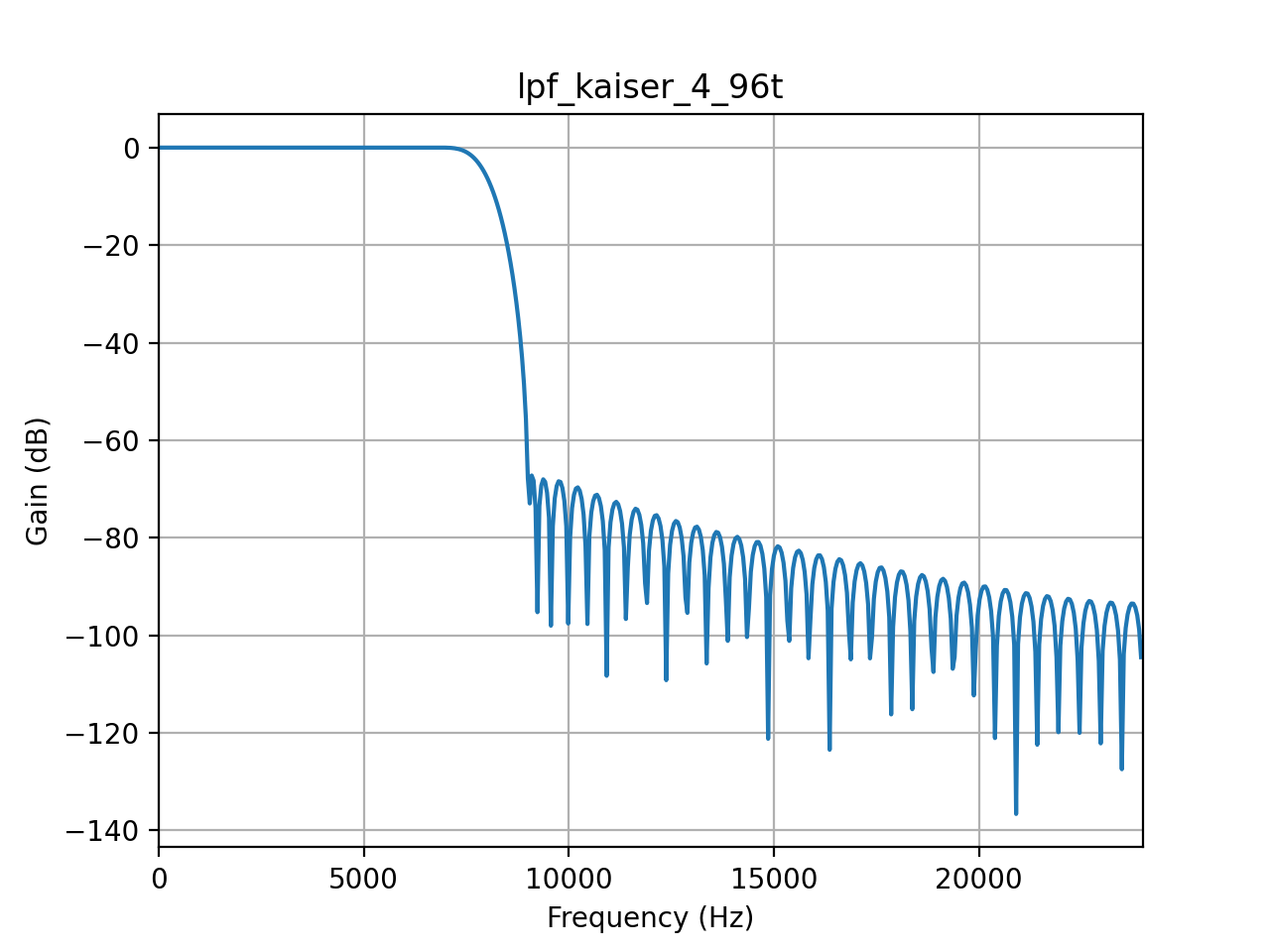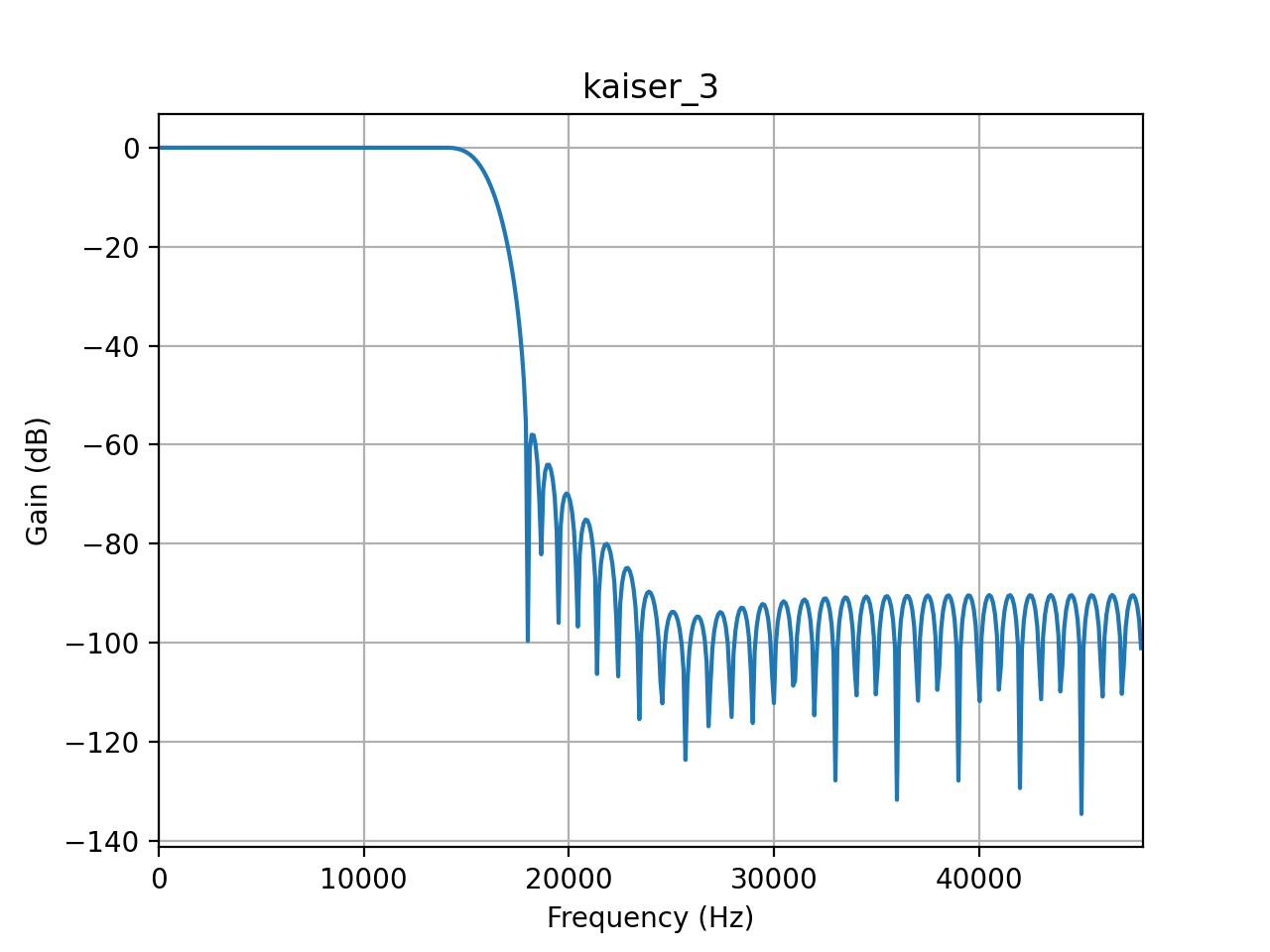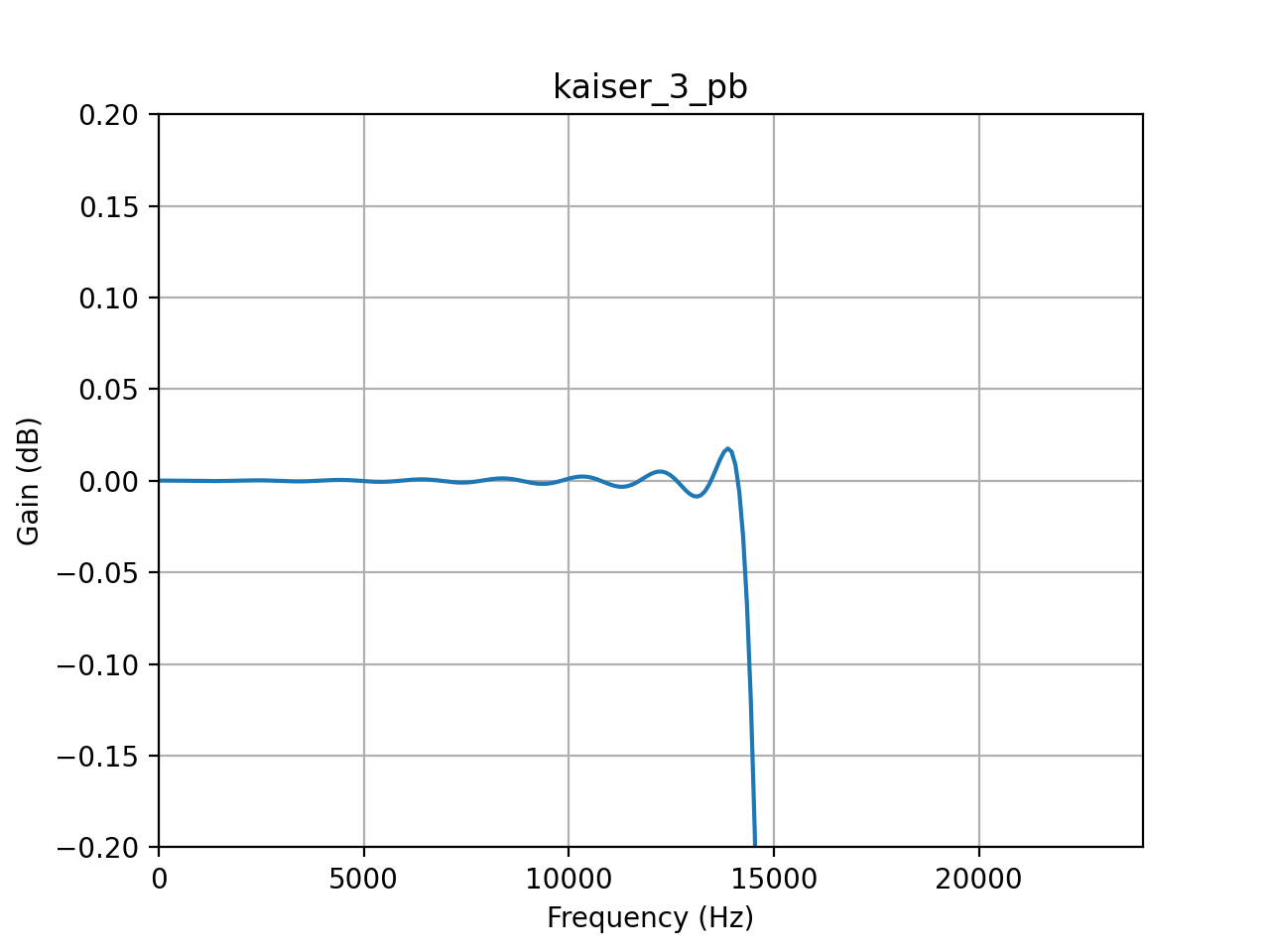Fixed factor of 3 HiFi functions#
Overview#
The SRC library includes synchronous sample rate conversion functions to downsample (decimate) and oversample (upsample or interpolate) by a fixed factor of 3.
These components offer a high quality conversion with an SNR of 130 dB.
In each case, the processing is carried out each time a single output sample is required. In the case of the decimator, three input samples are passed to the filter with a resulting one sample output on calling the processing function. The interpolator produces an output sample each time the processing function is called but will require a single sample to be pushed into the filter every third cycle. All samples use Q1.31 format (left justified signed 32b integer).
Both sample rate converters are based on a 144 tap FIR filter with two sets of coefficients available, depending on application requirements:
firos3_b_144.dat / firds3_b_144.dat - These filters have 20 dB of attenuation at the Nyquist frequency and a higher cutoff frequency
firos3_144.dat / firds3_144.dat - These filters have 60 dB of attenuation at the Nyquist frequency but trade this off with a lower cutoff frequency
The default setting is to use the coefficients that provide 60 dB of attenuation at the Nyquist frequency.
The filter coefficients may be selected by adjusting the line:
#define FIROS3_COEFS_FILE
and:
#define FIRDS3_COEFS_FILE
in the files src_ff3_os3.h (API for oversampling) and src_ff3_ds3.h (API for downsampling) respectively.
The OS3 processing takes up to 153 core cycles to compute a sample which translates to 1.53 \({\mu}s\) at 100 MHz or 2.448 \({\mu}s\) at 62.5 MHz core speed. This permits up to 8 channels of 16 kHz -> 48 kHz sample rate conversion in a single 62.5MHz core.
The DS3 processing takes up to 389 core cycles to compute a sample which translates to 3.89 \({\mu}s\) at 100 MHz or 6.224 \({\mu}s\) at 62.5 MHz core speed. This permits up to 9 channels of 48 kHz -> 16 kHz sample rate conversion in a single 62.5MHz core.
Both downsample and oversample functions return ERROR or NO_ERROR status codes as defined in the return code enums listed below. The only way these functions can error is if the passed delay_base structure member is uninitialized (NULL).
The downsampling functions return the following error codes
FIRDS3_NO_ERROR
FIRDS3_ERROR
The upsampling functions return the following error codes
FIROS3_NO_ERROR
FIROS3_ERROR
API#
DS3 API#
-
struct src_ds3_ctrl_t#
Downsample by 3 control structure
-
src_ff3_return_code_t src_ds3_init(src_ds3_ctrl_t *src_ds3_ctrl)#
This function initializes the decimate by 3 function for a given instance
- Parameters:
src_ds3_ctrl – DS3 control structure
- Returns:
SRC_FF3_NO_ERROR on success, SRC_FF3_ERROR on failure
-
src_ff3_return_code_t src_ds3_sync(src_ds3_ctrl_t *src_ds3_ctrl)#
This function clears the decimate by 3 delay line for a given instance
- Parameters:
src_ds3_ctrl – DS3 control structure
- Returns:
SRC_FF3_NO_ERROR on success, SRC_FF3_ERROR on failure
-
src_ff3_return_code_t src_ds3_proc(src_ds3_ctrl_t *src_ds3_ctrl)#
This function performs the decimation on three input samples and outputs one sample. The input and output buffers are pointed to by members of the src_ds3_ctrl structure
- Parameters:
src_ds3_ctrl – DS3 control structure
- Returns:
SRC_FF3_NO_ERROR on success, SRC_FF3_ERROR on failure
OS3 API#
-
struct src_os3_ctrl_t#
Oversample by 3 control structure
-
src_ff3_return_code_t src_os3_init(src_os3_ctrl_t *src_os3_ctrl)#
This function initializes the oversample by 3 function for a given instance
- Parameters:
src_os3_ctrl – OS3 control structure
- Returns:
SRC_FF3_NO_ERROR on success, SRC_FF3_ERROR on failure
-
src_ff3_return_code_t src_os3_sync(src_os3_ctrl_t *src_os3_ctrl)#
This function clears the oversample by 3 delay line for a given instance
- Parameters:
src_os3_ctrl – OS3 control structure
- Returns:
SRC_FF3_NO_ERROR on success, SRC_FF3_ERROR on failure
-
src_ff3_return_code_t src_os3_input(src_os3_ctrl_t *src_os3_ctrl)#
This function pushes a single input sample into the filter. It should be called three times for each FIROS3_proc call
- Parameters:
src_os3_ctrl – OS3 control structure
- Returns:
SRC_FF3_NO_ERROR on success, SRC_FF3_ERROR on failure
-
src_ff3_return_code_t src_os3_proc(src_os3_ctrl_t *src_os3_ctrl)#
This function performs the oversampling by 3 and outputs one sample. The input and output buffers are pointed to by members of the src_os3_ctrl structure
- Parameters:
src_os3_ctrl – OS3 control structure
- Returns:
SRC_FF3_NO_ERROR on success, SRC_FF3_ERROR on failure
Fixed factor of 3 functions optimized for use with voice#
Overview#
A pair of SRC components supporting upconversion and downconversion by a factor of 3 are provided that are suitable for voice applications. They provide voice quality SNR (around 60 dB) and use a 72 tap Remez FIR filter and are optimized for the XS2 instruction set.
Warning
These SRC components have been deprecated. For new designs using XCORE-AI, please use the XS3 optimized components which provide both much better performance and use approximately half of the MIPS. See ff3_voice_vpu_hdr
Voice DS3 API#
-
int64_t src_ds3_voice_add_sample(int64_t sum, int32_t data[], const int32_t coefs[], int32_t sample)#
This function performs the first two iterations of the downsampling process
- Parameters:
sum – Partially accumulated value returned during previous cycle
data – Data delay line
coefs – FIR filter coefficients
sample – The newest sample
- Returns:
Partially accumulated value, passed as
sumparameter next cycle
-
int64_t src_ds3_voice_add_final_sample(int64_t sum, int32_t data[], const int32_t coefs[], int32_t sample)#
This function performs the final iteration of the downsampling process
- Parameters:
sum – Partially accumulated value returned during previous cycle
data – Data delay line
coefs – FIR filter coefficients
sample – The newest sample
- Returns:
The decimated sample
Voice US3 API#
-
int32_t src_us3_voice_input_sample(int32_t data[], const int32_t coefs[], int32_t sample)#
This function performs the initial iteration of the upsampling process
- Parameters:
data – Data delay line
coefs – FIR filter coefficients
sample – The newest sample
- Returns:
A decimated sample
-
int32_t src_us3_voice_get_next_sample(int32_t data[], const int32_t coefs[])#
This function performs the final two iterations of the upsampling process
- Parameters:
data – Data delay line
coefs – FIR filter coefficients
- Returns:
A decimated sample
Fixed factor of 3 and 3/2 voice functions optimized for XS3#
Overview#
A set of SRC components are provided which are optimized for the Vector Processing Unit (VPU) and are suitable for voice applications. The fixed factor of 3 SRC components are designed for conversion between 48 kHz to 16 kHz and the fixed factor of 3/2 are designed for conversion between 48 kHz and 32 kHz.
They have been designed for voice applications and, in particular, conformance to the MS Teams v5 specification.
Note
These filters will only run on XCORE-AI due to the inner dot product calculation employing the XS3 VPU.
Warning
Synchronous fixed factor of 3 and 3/2 downsample and oversample functions for voice applications optimized for the XS3 Vector Processing Unit currently overflow rather than saturate in cases where a full scale input causes a perturbation above full scale at the output. To avoid this scenario, please ensure that the input amplitude is always 3.5 dB below full scale. The overflow behavior of these SRC components will be replaced by saturating behavior (to match all other SRC components) in a future release.
Fixed factor of 3 VPU#
The filters use less than half of the cycles of the previous fixed factor of 3 functions but at the same time offer a much improved filter response thanks to an increased filter length of 96 taps (compared with 72 taps) and use of a Kaiser window with a beta of 4.0. The filter specification is shown in Table 5.
Filter |
CPU cycles |
Passband |
Stopband |
Ripple |
Attenuation |
Taps |
|---|---|---|---|---|---|---|
src_ff3_96t_ds |
104 |
0.475 |
0.525 |
0.01 dB |
70 dB min |
96 |
src_ff3_96t_us |
85 |
0.475 |
0.525 |
0.01 dB |
70 dB min |
96 |
The fixed factor of 3 components produce three samples for each call passing one sample in the case of upsampling and produce a single sample for each call passing three samples in the case of downsampling. All input and output samples are signed 32 bit integers. The filter characteristics are shown in Fig. 7 and Fig. 8.

Fig. 7 Fixed Factor of 3 Voice VPU SRC filter response#

Fig. 8 Fixed Factor of 3 Voice VPU SRC passband ripple#
Voice DS3 API#
-
static inline void src_ff3_96t_ds(int32_t samp_in[3], int32_t samp_out[1], const int32_t coefs_ff3[3][32], int32_t state_ds[3][32])#
Performs VPU-optimised 96 taps polyphase fixed-factor-of-3 downsampling.
- Parameters:
samp_in – Values to be downsampled
samp_out – Downsampled output
coefs_ff3 – Three-phase FIR coefficients array with [3][32] dimensions
state_ds – Three-phase FIR state array with [3][32] dimensions
Voice US3 API#
-
static inline void src_ff3_96t_us(int32_t samp_in[1], int32_t samp_out[3], const int32_t coefs_ff3[3][32], int32_t state_us[32])#
Performs VPU-optimised 96 taps polyphase fixed-factor-of-3 upsampling.
Note
samp_in and samp_out have to be different memory locations
- Parameters:
samp_in – Value to be upsampled
samp_out – Upsampled output
coefs_ff3 – Three-phase FIR coefficients array with [3][32] dimensions
state_us – FIR state array with 32 elements in it
Fixed factor of 3/2 VPU#
The fixed factor of 3/2 VPU sample rate converts use a rational factor polyphase architecture to achieve the non-integer rate ratio. Downsampling takes two phases while upsampling takes three. The filters have been designed with a Kaiser window with a beta of 3.2. The filter specification is shown in Table 6.
Filter |
CPU cycles |
Passband |
Stopband |
Ripple |
Attenuation |
Taps |
|---|---|---|---|---|---|---|
src_rat_2_3_96t_ds |
112 |
0.46875 |
0.53125 |
0.03 dB |
70 dB |
96 |
src_rat_3_2_96t_us |
95 |
0.46875 |
0.53125 |
0.03 dB |
70 dB |
96 |
The fixed factor of 3/2 components produce three samples for each call passing two samples in the case of upsampling and produce two samples for each call passing three samples in the case of downsampling. All input and output samples are signed 32 bit integers. The filter characteristics are shown in Fig. 9 and Fig. 10.

Fig. 9 Fixed Factor of 3/2 Voice VPU SRC filter response#

Fig. 10 Fixed Factor of 3/2 Voice VPU SRC passband ripple#
Voice DS3/2 API#
-
static inline void src_rat_2_3_96t_ds(int32_t samp_in[3], int32_t samp_out[2], const int32_t coefs_ds[2][48], int32_t state_ds[48])#
Performs VPU-optimised 96 taps polyphase rational factor 2/3 downsampling.
- Parameters:
samp_in – Values to be downsampled
samp_out – Downsampled output
coefs_ds – Two-phase FIR coefficients array with [2][48] dimensions
state_ds – FIR state array with 48 elements in it
Voice US3/2 API#
-
static inline void src_rat_3_2_96t_us(int32_t samp_in[2], int32_t samp_out[3], const int32_t coefs_us[3][32], int32_t state_us[32])#
Performs VPU-optimised 96 taps polyphase rational factor 3/2 upsampling.
Note
samp_in and samp_out have to be different memory locations
- Parameters:
samp_in – Values to be upsampled
samp_out – Upsampled output
coefs_us – Three-phase FIR coefficients array with [3][32] dimensions
state_us – FIR state array with 32 elements in it